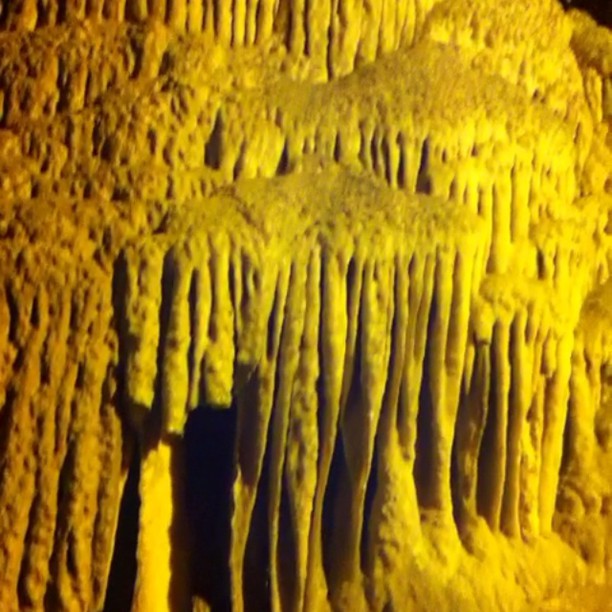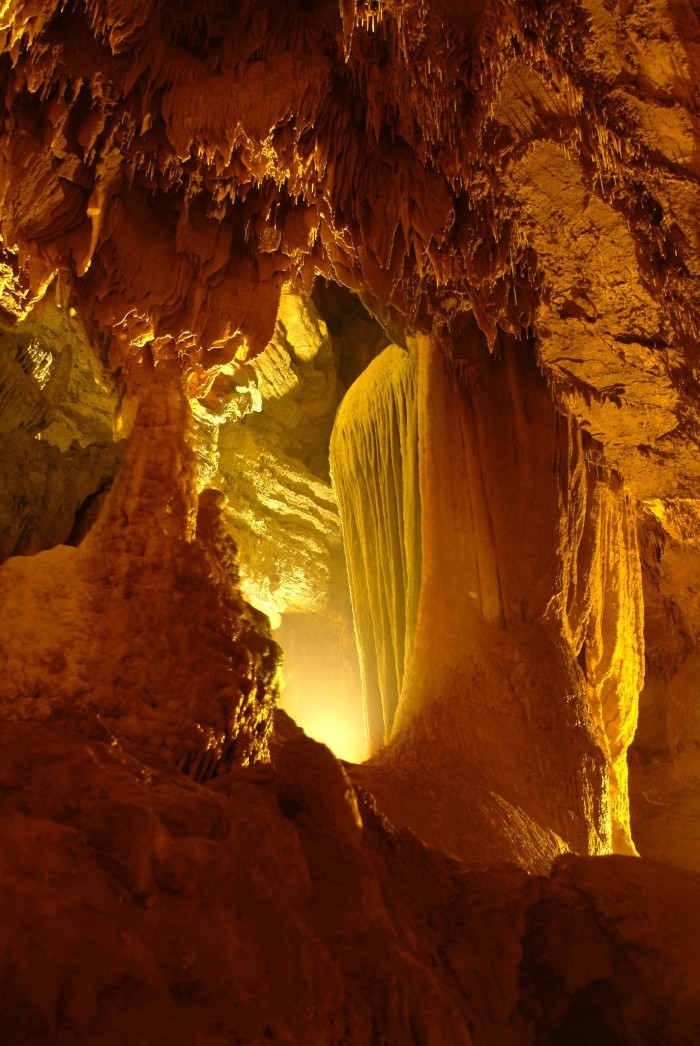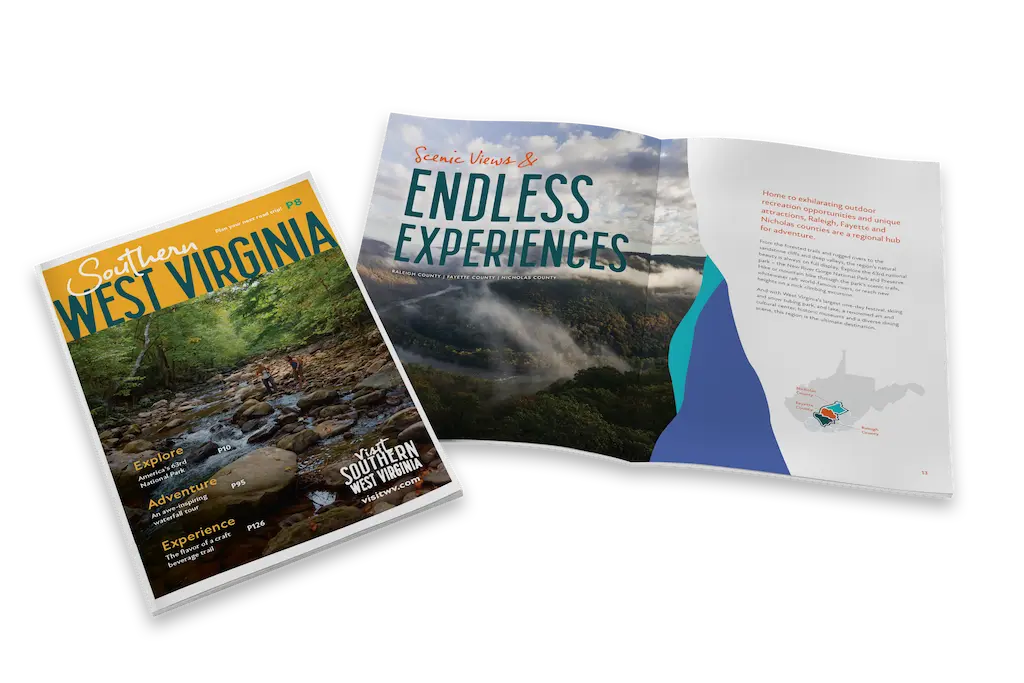History & mystery under the Earth
April 25, 2016A resting place for prehistoric animals. A commercial tourist attraction. A preserve for underground ecosystems. A beautiful canvas of nature’s artistry. A Guinness record. A site for sensational national news.
Lost World Caverns has been all of these and more.
West Virginia has no shortage of great caves to explore— our rugged topography, ample watersheds and underground layers of limestone all combine to give us hundreds of miles of underground passages, many of which are still not fully mapped.
But of all the Mountain State’s caves, perhaps none have the history, accessibility and beauty of Lost World Caverns, just outside Lewisburg.
It’s fairly easy to pay your $12, throw on a jacket for the cave’s 52-degree temperatures, and walk through beautiful passages of stalactites and stalagmites. But if you’re just taking a quick walk-through, you’re really only scratching the surface (no pun intended!) of this fascinating place.
The entire landscape Greenbrier County in Southern West Virginia sits on is what geologists call a “karst plateau”— a tableland of limestone that is being chemically eroded by water into swiss cheese-like passages. Water seeps into the ground and flows downward with the complex topography, before finally emerging as springs that feed above-ground waterways like the scenic Greenbrier River. Hundreds of “sinkholes,” which are pits water drains through into the ground, dot the landscape.
Lost World Caverns, originally called Grapevine Cave, was originally only accessible through one of these sinkholes. Farmers used it as a garbage disposal, dumping refuse into it. It was not until 1942 that researchers from Virginia Tech finally discovered where this hole in the ground went.
The sinkhole actually led more than 120 feet into the earth’s surface, into a gargantuan main chamber that is now the focus of the cave’s walking tour. This vaulted chamber is 1000 feet long, 300 feet wide and 120 feet high; many of Europe’s grandest cathedrals could easily fit inside it.
Beyond this main chamber, the cave extends deeper and into more wild territory for more than a mile. Passages with names like “The Birth Canal” and “The Drain” (for obvious reasons) extend hundreds of feet deeper into the earth.
If you’re more adventurous, you can take a Wild Cave Tour through this extended section.
Geology
There’s a saying: “Geologic time includes now.” In other words, the world we live in is not static and unchanging, but in a constant state of flux, of minerals either building up or being eroded and carried away. This is abundantly clear in Lost World Caverns. The entire cavern is the product of hydrogen ions in water reacting with the calcium carbonate of limestone on a molecular level, gradually excavating fissures, pockets and huge halls over the eons.
This mineralized water does not just dissolve and degrade, though; it creates beautiful formations as well. As tiny droplets of mineral-saturated water perform their “drip-drip,” they leave traces of calcium carbonate clinging to the ceiling. Over time, that develops into huge stalactites– fangs of limestone that resemble icicles. They can be dozens of feet long.
Droplets of water can also gradually deposit minerals on the cavern floor, forming ground-up pillars of stone called stalagmites.
It’s a slow process, but over time, these formations can become hugely impressive.
The main cavern has some of the largest and most intricate stalactites and stalagmites in the nation. Experts estimate the “Snowy Chandelier” stalactite weighs more than 30 tons; the white calcite of the “Bridal Veil” sparkles radiantly; the “War Club” is a 28-foot-tall stalagmite that looks just like its namesake.
Biology
 Lost World Caverns is not just about geological history, though. Living things have left their trace here, too.
Lost World Caverns is not just about geological history, though. Living things have left their trace here, too.
In 1967, paleontologists discovered teeth and a partial femur bone of Arctodus pristinus, a prehistoric cave bear from the Pleistocene era. The bear may have stood nearly 15 feet high, more massive than today’s largest bears.
Just last year, a guide and employee of Lost World discovered more complete remains of a prehistoric black bear on a ledge above the main cavern. At about 32,000 years old, the skull of this bear is about 2.5 times the size of modern black bears.
You can see both the cave bear and the black bear remains at the cave’s adjacent museum, as well as a selection of fossils from West Virginia’s more distant dinosaur past.
The caverns house native critter, like salamanders, rodents and little brown bats. Cave owner Steve Silverberg has made it a point not just to run a cave people can explore, but also to work with scientists and students from nearby universities to preserve the delicate underground ecosystem here.
When Silverberg, a San Diego native with a background in geology, purchased the cave and its above-ground property in 1999, it was in a state of disrepair. The museum building had “more shingles on the ground than on the roof,” garbage from the cave’s days as a dumping hole was still strewn around and sodium vapor from floodlights had prompted an outbreak of an invasive green mold that was threatening native species.
To protect the cave, Silverberg is in the process of installing special lights to cut down on mold growth. Surveyors and scientists are actively cataloging modern and prehistoric animals in the passages, and Wild Tour visitors have to go through sterilization procedures before they enter this ecosystem.
History
Preservation and paleontological digs are a significant change from the cave’s early human history.
From the 1960s on, the caverns were developed for mass visitation, with a tunnel entrance, electric lights and paved walkways around the main chamber.
In 1971, the War Club stalagmite became the site of an official Guinness World Record when cave lover Bob Addis sat on top of it just a half hour shy of 16 days (with the assistance of a “bucket man.” You probably don’t want to know what that is.)
2 years later, in 1973, the caverns were given the distinguished title of National Natural Landmark by the National Park Service.
The caverns even had a role in one of the 1990s’ great stories of tabloid pop culture. If you are of a certain age, you will certainly remember the Weekly World News, a newspaper of mostly fictional stories that filled supermarket checkout lines from 1979 to 2007. One of its most famous recurring stories was of a wide-eyed, gaping humanoid creature named “Bat Boy.” Bat Boy first graced the front page in 1992 when he was “discovered,” and made sporadic appearances throughout later years, as he was captured, escaped and eventually ran for governor of California in 2003!
Although the Weekly World News originally credited the fictional “Hellhole Cave” as the home of this mythical creature, Lost World Caverns has since claimed this campy story as its own. The original cover story of Bat Boy hangs in the Caverns’ gift shop, and Silverberg even donated real caving gear to an off-Broadway musical based on the Bat Boy story.
So, keep your eyes open if you take the Wild Cave Tour. You may catch a glimpse of this elusive creature!


